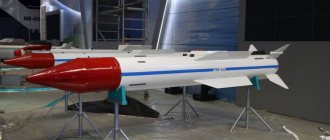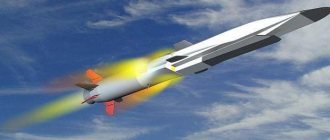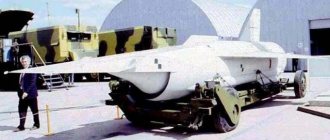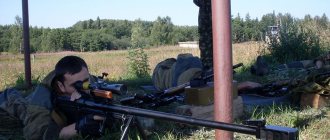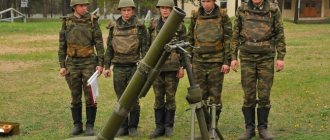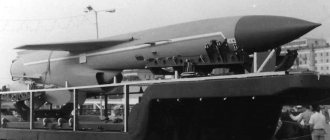S-400 Triumph air defense system. Damage range. Rockets. How does it work
S-400 "Triumph" (40Р6) (according to NATO classification SA-21 Growler (Russian: Grumpy)) is a new generation air defense system that replaced the well-known S-300P and S-200 air defense systems. In the coming years it should become the basis air defense of Russia, 56 divisions should be supplied to the troops by 2022. The complex is designed to destroy all types of targets (aircraft, UAVs, cruise missiles, etc.) at a distance of up to 400 km and at an altitude of up to 30 km. According to estimates experts, the complex has a more than twofold advantage over previous generation systems.
“Made with us” and on Yandex.Zen
- © rg.ru
Thanks to the ultra-long-range guided maneuvering missile 40N6, the S-500 system can hit targets at an altitude of up to 250 km and at a distance of up to 500 km.
Developing a speed of up to 9 Mach, a missile with a high-explosive fragmentation warhead is capable of destroying objects flying at speeds of up to 15.6 M. To destroy four types of aerospace targets, the principle of specialization of radars and missiles is provided depending on the tasks being solved. The new generation S-500 Prometheus air and missile defense system will become the basis of the national defense system against aerospace attacks. Unlike many other military innovations, work on it is not advertised - it is only known that the development of the S-500 is included in the state arms program of the Russian Federation until 2027. The characteristics of the system are also classified. But on Air Defense Forces Day, you can open some of them.
The S-500 will be in every sense the pinnacle of the air defense-missile defense system - it is designed to operate at altitudes inaccessible to other systems, 100 kilometers and above, that is, in near space. Most of the military satellites of different countries operate there, responsible for reconnaissance, communications, navigation and target designation. The tops of the trajectories of ballistic missiles are also located there - at an altitude of hundreds of kilometers, warheads are separated from the missiles and, surrounded by a swarm of false targets, rush back to the ground at exorbitant speeds. Until now, near space has remained a quiet corner, inaccessible to weapons of destruction. The first hunter in this “reserve” will be “Prometheus”.
According to data from open sources, the complex will receive an ultra-long-range 40N6 guided missile with a destruction altitude of 200-250 kilometers. Ground-based radars in space cannot help the rocket, so the 40N6 has a control system different from other missiles. Its fundamentally new homing head can operate in both semi-active and fully active modes - upon command from the ground, the missile switches to independently searching for a target and, having detected it, is aimed autonomously.
A two-stage solid-propellant missile about nine meters long has a speed of up to Mach 9 and can intercept targets flying at a speed of 15.6 Mach. To do this, the missile maneuvers with an overload of 25 units. This is far from the limit for missile defense systems - the Russian 53T6 anti-missile missiles in service can withstand overloads of 200 units.
The 40N6 warhead is high-explosive fragmentation, has a range of 500 kilometers, and has a 95 percent probability of hitting a target. In 2022, state tests of a long-range anti-aircraft guided missile were reported.” With a high degree of probability we can assume that we are talking about 40N6.
Another feature of Prometheus will be the system architecture. If in previous generations of complexes one universal radar was responsible for detecting, capturing and tracking all types of targets, then the S-500 uses several specialized radars, whose characteristics are adapted to a specific type of aircraft.
Relatively speaking, one radar deals with airplanes and helicopters, another with cruise missiles, a third with ballistic missiles, and a fourth with satellites. Similar to radars, each complex will be armed with specialized missiles for each type of target - a similar arsenal, although not as wide, is already available in the S-400 Triumph complex.
Recently, one of the components of the S-500 was highlighted in a news release - the Yenisei radar helped track targets during the demonstration exercises of the Aerospace Forces at the Astrakhan Ashuluk training ground.
S-400 Triumph air defense system - video
The S-400 Triumph air defense system is the only system in the world capable of operating with the selective use of more than 4 types of missiles, differing in different launch weights and launch ranges, which ensures the creation of layered defense. The complex was put into service on April 28, 2007. The first division, armed with the S-400, was put on combat duty on April 5, 2007. Currently there are 4 divisions in service. By 2015, more than 20 divisions of the S-400 Triumph air defense system should be sent to the troops. It is planned that this system will be used to ensure the security of the Winter Olympic Games, which will be held in Sochi in 2014. The system has significant export potential and attracts the attention of many countries, including China and the UAE. It is assumed that export deliveries will begin only when the state defense order is fully completed.
Application of S-400
The S-400 air defense system is designed to destroy a wide range of not only modern, but also promising air attack weapons, including:
- strategic and tactical aviation aircraft - reconnaissance aircraft - radar patrol and guidance aircraft - jammer aircraft - medium-range ballistic missiles - operational-tactical and tactical ballistic missiles - hypersonic targets
The S-400 Triumph air defense system ensures the destruction of aerodynamic targets at a distance of up to 400 km, at a target altitude of up to 30 km. The maximum speed of targets hit is up to 4,800 m/s. The missiles used as part of the complex have a fragmentation warhead with a controlled field of destruction, which guarantees the elimination of the possibility of the warhead of an attacking missile falling in the area of the protected object. This possibility can be completely excluded only if the target’s payload is destroyed by intercepting it with an anti-aircraft missile. In turn, a similar effect can be achieved either as a result of a direct hit by a missile on a target, or by combining a small miss and the effective impact of fragments of an anti-aircraft missile warhead on the target.
S-400 air defense missile launcher - a semi-trailer attached to a BAZ-64022 truck tractor
The basic version of the S-400 Triumph air defense system consists of:
— anti-aircraft missile systems — multifunctional radar — autonomous means of detection and target designation — command post — system technical support complex — means of technical operation of anti-aircraft missiles
All elements of the system are based on off-road wheeled chassis and allow for transportation by rail, air or water transport. The command post of the complex has a radar that creates a radar field within the range of the system and carries out detection, route tracking, and determination of the nationality of all types of targets in a quantity estimated at up to 300 units. The detection radar is equipped with a phased array with two-dimensional scanning, operates in all-round viewing mode, is three-dimensional and protected from interference. With active radio countermeasures from the enemy, it operates in constant frequency tuning mode.
Command post of the S-400 55K6E air defense missile system on the Ural-532301 chassis
Using the data received from the detection radar, the command post distributes targets between the system complexes, transmitting to them the appropriate target designations, as well as linking the actions of the air defense system in conditions of the massive use of air attack weapons at all reachable altitude levels with the active use of radio countermeasures. The air defense system command post is capable of receiving additional track information on targets from higher command posts, in whose interests ground-based radars in standby and combat modes operate, or directly from the radars themselves, as well as from the onboard radars of aviation complexes. Comprehensive acquisition of radar information from various sources in different wavelength ranges is most effective in conditions of strong radio countermeasures from the enemy. The S-400 air defense system is capable of simultaneously controlling 8 air defense systems with a total number of launchers up to 12 on each complex.
One launcher can carry up to 4 ultra-long-range 40N6E missiles (up to 400 km), which are designed to destroy DLRO aircraft, electronic warfare aircraft, enemy airborne command posts, strategic bombers and ballistic missiles at speeds of up to 4,800 m/s. This missile is capable of destroying targets beyond the radio visibility of ground-based guidance locators. The need to hit over-the-horizon targets led to the installation of a new homing head (GOS) on the missile, created by NPO Almaz. This seeker operates in semi-active and active modes. In active mode, after reaching the required altitude, the rocket is switched to search mode and, having found the target, aims at it independently.
Multifunctional control radar with phased array 92N2E
Action of rockets
Unlike its foreign counterparts, the ZRS-400 uses the so-called “cold” launch of missiles. Before the propulsion engine is launched, the rocket is ejected from the launch container to a height exceeding 30 m. During the rise to this height, the rocket, thanks to the gas-dynamic system, tilts towards the target. After the main engine is started, inertial radio correction control is used in the initial and middle stages of the flight (this allows for maximum resistance to interference), and active radar homing is used directly in the target interception phase. If there is a need for intensive maneuvering before hitting a target, the missile is able to switch to “super-maneuverability” mode. To enter the mode, a gas-dynamic control system is used, which allows for 0.025 s. increase the aerodynamic overload of the rocket by more than 20 units. The use of such “super-maneuverability” together with increased guidance accuracy improves the conditions for an anti-aircraft missile to meet a target, which increases its effectiveness.
S-400 Triumph air defense missiles - 48N6E2, 9M96E2, 9M96E
The missiles used in the S-400 air defense system are equipped with a 24-kg fragmentation warhead, which has a controlled destruction field. Such equipment of the missile allows it to hit targets with a “stopping” effect (destruction of the structure) when intercepting manned targets or destroying the warhead in the event of intercepting unmanned targets. The missile warhead is controlled using a radio fuse, which is able to use all the information available on board the missile to adapt to the conditions of the meeting with the target. The radio fuse calculates the moment of detonation of the missile warhead in strict accordance with the speed of dispersion of fragments, in order to cover the most vulnerable areas of the target with a fragmentation field, and the direction in which it is necessary to provide a fragmentation cloud. The directed release of fragments is realized using a controlled high-explosive fragmentation warhead, which has a multi-point initiation system. This system, upon command from the radio fuse to fire the warhead in a controlled mode (with available information about the miss phase), causes the charge to detonate at the required peripheral detonation points. As a result, the explosion is redistributed and a fragmentation cloud is formed in the required direction. If there is no information about the miss phase, the central warhead is detonated with symmetrical scattering of fragments.
All-altitude detector 96L6E
Today, the S-400 Triumph air defense system has more than twofold superiority over its predecessors. The command post of this anti-aircraft missile system is capable of integrating it into the control structure of any air defense. Each air defense system of the system is capable of firing up to 10 air targets with up to 20 missiles aimed at them. According to foreign experts, the complex has no analogues in the world. The S-400 air defense system provides the ability to build a layered defense of ground targets against a massive air attack. The system ensures the destruction of targets flying at speeds of up to 4,800 m/s at a range of up to 400 km. at target heights of up to 30 km. At the same time, the minimum firing range of the complex is only 2 km, and the minimum height of the targets hit is only 5 m. For example, the American Patriot complexes are not capable of destroying targets flying below 60 m. The time for full deployment from traveling state to combat readiness is 5-10 minutes. The system is distinguished by the automation of all processes of combat work - target detection, their route tracking, distribution of targets between air defense systems, target acquisition, selection of missile type and preparation for launch, evaluation of firing results.
Important new characteristics of the system are:
— information interface with the majority of existing and newly developed sources of information of ground, air or space deployment; — the use of a basic-modular principle, which makes it possible to satisfy the specific requirements that are imposed on the system when used in the Air Force, Ground Forces or Navy; — the possibility of integration into existing and future control systems for air defense groups not only of the Air Force, but also of military air defense or naval air defense forces.
5:02 / 21.10.18 Anti-aircraft guided missile 40N6 - long-range and anti-satellite
October 2022 will undoubtedly go down in history. It was this month that TASS reported the adoption of the long-awaited 40N6 long-range anti-aircraft guided missile (SAM) for the S-400 Triumph anti-aircraft complex. This became possible after successful state tests in July this year. It is sometimes called a “long arm” or ultra-long-range missile. Now, with good reason, this air defense system can be called a triumph, because there are no others like it in its class. It was previously reported that the 40N6 missiles, after some modernization, will become the main one for the promising S-500 Prometheus air defense systems.
Launch of UR 40N6 / Photo: ic.pics.livejournal.com
According to TASS, in total, within the framework of the state armament program until 2027, it is planned to purchase over a thousand 40N6 to equip the newly formed and re-equip existing S-400 regiments of the Aerospace Forces with them. The same program provides for the formation of up to 56 S-400 divisions within the Aerospace Forces.
PU S-400 at the Victory Parade / Photo: bastion-karpenko.ru
The 40N6 missile defense system
is designed to combat AWACS, electronic warfare aircraft, air command posts, strategic bombers, hypersonic cruise and ballistic missiles.
In addition, according to experts and taking into account the known characteristics, it can be quite successfully used to combat targets in near space. Equipping the missile with a new homing head allows it to fire and engage targets beyond the visibility of ground-based radars. The new missile defense system was developed by the Fakel Design Bureau, and serial production was launched at the Avangard MMZ.
SAM 48N6E / Photo: IA “ARMS OF RUSSIA”, Anatoly Sokolov
Main indicators of the 48N6 missile defense system: maximum range of destruction of aerodynamic (medium-range ballistic missiles) targets - 380 (15) km; minimum destruction range - 5 km; maximum height of damage - 30 km; average flight speed - 1190 m/s; weight of missiles in TPK - 2600 kg; launch weight - 1893 kg; TPK dimensions - 7825x1000 mm; the assigned service life is 15 years. For comparison, the current 9M96, 48N6, 48N6DM missiles, already in service with the S-400, ensure the destruction of targets at a range of up to 250 km. The target is hit by a “direct” impact warhead.
The missile is equipped with a fundamentally new seeker, capable of operating in semi-active and active modes. In the second case, the missile defense system, after climbing to altitude, on command from the command post, goes into target search mode and, after detecting it, goes into homing mode. It is possible to independently search for and destroy a target with a missile, including in the event of loss of contact with the ground command post.
Reports of the availability of an export version of the 40N6E give grounds to assert that a complex with this missile may appear abroad. This suggests that our Western “friends” will still have to worry. The “three hundredth” complex has already made a “rustle”; the “four hundredth” is next.
Deployment of the S-400 air defense system at a firing position / Photo: militaryreview.ru
It is noteworthy that the four-year testing of the rocket took place in complete secrecy. Such a long launch range is a unique characteristic in itself. But even more important is that the missile, according to some sources, is capable of hitting targets at an altitude of up to 185 km. As calculations show, the most advanced US air defense system THAAD, with a range and altitude of 200 km and 200 km, respectively, has a maximum slant range of no more than 280 km. A similar indicator for missiles of the 40N6 type is up to 440 km. It is also important that the rocket has a very high flight speed - up to 4.5 km/sec (440 km will fly in 100 seconds).
It is assumed that this missile defense system can enter service with the Russian Navy. In this case, the American Aegis will be significantly inferior to the 400 and 500.
Source: IA "ARMS OF RUSSIA", Anatoly Sokolov
Tags: Armament, development, missiles, 48N6. long-range, anti-satellite
Tactical and technical characteristics of the S-400 Triumph air defense system
— Constructor: NPO Almaz named after. A. A. Raspletina - Manufacturer: Almaz-Antey - Adopted: April 28, 2007
Destruction range of the S-400 Triumph air defense system
— Detection range, km: 600
Cover zone boundaries in range - maximum - 400 km - minimum - 2 km
Cover zone boundaries in height from aerodynamic targets - maximum - up to 30 km (40N6E missile) / up to 27 km (48N6DM missiles) / up to 35 km (9M96M missiles) - minimum - 0.005 km
Borders of the cover zone in terms of range from all available ballistic missiles - maximum - 60 km - minimum - 5 km
— Maximum target speed, km/s: 4.8 — Maximum targets fired at the same time: 80 (10 targets each SAM, up to 8 SAMs in total under common control) (until 2012 — 36 (6 SAMs for 6 targets)) — Guided missiles on target maximum: 160 (20 missiles each SAM, up to 8 SAMs in total under common control) - Readiness, minutes: 0.6 from standby mode / deployed on the ground 3 - Continuous operation hours: 10,000 - Service life: Components minimum 20 years. 15 years of rockets
youinf.ru
40N6 is an ultra-long-range anti-aircraft guided missile (SAM) over 400 km with the ability to intercept targets in near space for the S-400/S-500 air defense systems.
40N6 is designed to destroy aircraft and ballistic targets with a maximum speed of more than 4800 m/s. The missile can destroy targets beyond the visibility of ground-based guidance radars.
The ability to hit over-the-horizon targets required the creation of a fundamentally new homing head (GOS) for the 40N6 missile defense system, which can operate in both semi-active and active modes. In the latter case, the missile defense system, after gaining altitude on command from the ground, goes into search mode and, having detected the target, aims at it independently.
In addition, the seeker of the 40N6 missile is capable of searching for and hitting targets independently even after losing contact with ground systems.
TTX
| Parameter | Values |
| Rocket | 40N6 |
| Type | Long range missile defense |
| Mass production | MMZ "Avangard" |
| Length | 8.7m |
| Diameter | 0.575 m |
| Stabilizer span | 1.134 m |
| Weight | 2500 kg |
| Warhead mass | 145-180 kg |
| Warhead types | High explosive |
| Range | 400-460 km. According to other sources, up to 600 km. |
| Damage height | 200-250 km. |
| Maximum speed | >9M |
| Maximum target speed | >4.8 km/sec (>15.6M) |
| Permissible overload | >25G |
| Probability of target hit | 0.95 |
| Time to prepare for launch | no more than 8 seconds |
| Life time | 15-20 years |
| Rocket design | Two-stage solid propellant with a supporting body and aerodynamic rudders-stabilizers |
| Control system and guidance | Combined: inertial control system + seeker developed by Almaz Central Design Bureau, active-semi-active with switching to target search mode at the command of the air defense missile system. After detecting a target in the “search” mode, the active radar directs the missile to the target. |
| PAD | There is |
| Engine 1st stage | Solid propellant rocket engine |
| Engine 2 stages | Solid propellant rocket engine |
Data obtained from open sources.
Keep in mind that domestic developers usually underestimate the capabilities of their products.
On June 28, 2012, the commander of the air defense and missile defense forces of the Russian Aerospace Defense Forces, Major General Andrei Demin, announced in the media that the new long-range missile defense system for the S-400 system had successfully passed tests.
On March 7, 2022, Russian Defense Minister Sergei Shoigu announced at a conference call about considering the results of state tests of a “promising long-range missile defense system.”
“We will also consider how state tests of a promising long-range anti-aircraft guided missile are going,” Shoigu said on Rossiya 24.
Thus, we can expect that the 40N6 missile defense system (and we were probably talking about it) will soon enter service.
Photo of S-400 Triumph air defense system
Similar
ZSU-23-4 Shilka. Rate of fire. Armament. Dimensions. Weight
S-75 air defense systems Dvina, Desna, Volkhov. Compound. Rockets. Damage range
ZRPK Pantsir-S1. Armament. Price. Detection range
S-350E Vityaz air defense system. Compound. Rockets. Damage range
OSA-AKM air defense missile system. Firing range. Rockets. Compound. Dimensions. Weight
ZSU 2S6M Tunguska-M. Damage range. Rockets. Compound. Dimensions
ZRK 2K12 KUB. Damage range. Rocket speed. Principle of operation
SAM Buk-M1-2. Detection and destruction range. Rockets. Possibilities
SAM S-200 Angara, Vega, Dubna. Damage range. Compound. Principle of operation
MANPADS 9K310 Igla-1. Damage range. Weight. Possibilities
SAM 9K331 Tor-M1. Damage range. Rocket. Principle of operation
MANPADS Verba. Damage range. Rocket. Composition of the complex
SAM S-125 Neva (Pechora) Range and height of destruction. Rockets
S-400 Triumph air defense system. Damage range. Rockets. How does it work
SAM 9K35 Strela-10. Damage range. Modifications. Rockets
SAM S-300PMU2 Favorite. Damage range. Compound. Rockets
SAM S-25 Berkut. Range and altitude of damage. Rockets
SAM Sosna. Armament. Damage range. Rockets. Compound
American Patriot air defense system. Damage range. Compound. Rockets
Naval air defense missile system Dagger. Damage range. Compound. Rockets. On what ships is it installed?
ZRK 2K11 Circle. Damage range. Modifications. Compound
Anti-aircraft gun ZSU-57-2. Armament. Dimensions. Booking
KTPU "Gibka" (3M-47) Damage range. Rockets. Principle of operation
"Osa-M" - shipborne anti-aircraft missile system
MANPADS 9K34 "Strela-3"
FIM-92A Stinger - American MANPADS
S-300V (9K81) - anti-aircraft missile system
9S482M7 (PU-12M7) - battery-operated mobile control station
SAM "Avenger" - American mobile anti-aircraft missile system
MANPADS 9K32 "Strela-2"
SAM M-1 "Volna" (4K90) - ship-based anti-aircraft missile system
MD-PS - anti-aircraft missile system
ZSU-37 - self-propelled anti-aircraft gun
